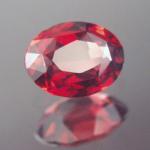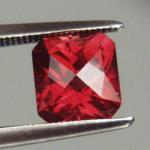
Classes- Alabama
- Alaska
- Arizona
- Arkansas
- California
- Colorado
- Connecticut
- Delaware
- Florida
- Georgia
- Hawaii
- Idaho
- Illinois
- Indiana
- Iowa
- Kansas
- Kentucky
- Louisiana
- Maine
- Maryland
- Massachusetts
- Michigan
- Minnesota
- Mississippi
- Missouri
- Montana
- Nebraska
- Nevada
- New Hampshire
- New Jersey
- New Mexico
- New York
- North Carolina
- North Dakota
- Ohio
- Oklahoma
- Oregon
- Pennsylvania
- Rhode Island
- Tennessee
- Texas
- Utah
- Vermont
- Virginia
- Washington
- West Virginia
- Wisconsin
- Wyoming
| Structure : Trigonal Hardness : 7.5 Specific Gravity : 3.06 Refractive index : 1.62 - 1.6 Doubly Refracting (bi-refraction) : 0.018 Tourmaline's name comes from the Sinhalese tura mali , which means "mixed stone." Available in a rainbow of colors and color combinations, tourmaline lives up to its name. Legend says tourmaline inspires artistic expression and enhances your intuition. Certainly this gem's varied palette inspires designers to create jewelry to suit every mood. Tourmaline offers an enticing rainbow of options for your jewelry wardrobe. Cranberry red, hot magenta, bubblegum pink, peach and orange, canary yellow, mint, grass and forest green, ocean blue, violet, and even bicolor pink and green stones: tourmaline is all these and more. The most valuable colors of tourmaline are the rare electric blues and greens discovered in Paraiba, Brazil in 1989. Such gems can command tens of thousands of dollars per carat. Blue indicolite, red rubellite, and green chrome tourmaline are also coveted and fine-quality material is hard to find and highly valued. Pink and mint green tourmaline, however, is widely available and more affordable, with prices in the hundreds of dollars per carat. The Empress Dowager Tz'u Hsi, the last empress of China, loved pink tourmaline above all other gemstones. She imported tons of tourmaline from Southern California in the early twentieth century, creating a gem rush in San Diego during the period. In addition to unusually varied beauty, tourmaline has unusual electrical properties. Crystals acquire a polarized electrical charge when heated or compressed. This property has also made tourmaline the latest miracle ingredient in moisturizers: manufacturers claim the gem helps pull pollutants from your skin. Almost every color of tourmaline can be found in Brazil, especially in Minas Gerais and Bahia. In addition to Brazil, tourmaline is also mined in Tanzania, Kenya, Nigeria, Madagascar, Mozambique, Namibia, Afghanistan, Sri Lanka, and California and Maine in the United States. Because they grow in thin pencil-like crystals, tourmalines are most often cut into long rectangular shapes known as emerald cuts. The pink colors of tourmaline can be enhanced with exposure to radiation and some blues and greens improve with heat but the results are stable and undetectable, so no one knows how common these practices are. Red tourmaline, which is often very included, can sometimes have surface-reaching fissures filled with resin to make them less visible. Tourmaline is durable and suitable for everyday wear. Clean with mild dish soap: use a toothbrush to scrub behind the stone where dust can collect. |
- Birth Stone Gems
- Wedding & Anniversary Gems
- How To Guides
- Fireable Gems
- Nonprofits and Guilds
- Gem Show
- Gem Stone Information
- ·Abalone
- ·Achroite (Tourmaline)
- ·Agate ( Chalcedony)
- ·Alexandrite
- ·Almandine ( Garnet )
- ·Amber
- ·Amethyst ( Quartz)
- ·Ammolite
- ·Andalusite
- ·Andradite Garnet
- ·Apatite
- ·Aquamarine ( Beryl )
- ·Aventurine ( Quartz )
- ·Azurite
- ·Benitoite
- ·Bloodstone ( Chalcedony )
- ·Brown Quartz ( Smokey Quartz )
- ·Calcite
- ·Carnelian ( Chalcedony )
- ·Cassiterite
- ·Celestine
- ·Cerussite
- ·Chalcedony
- ·Chatoyant Quartz
- ·Chrysoberyl
- ·Chrysocolla
- ·Chrysoprase (Chalcedony)
- ·Citrine ( Quartz )
- ·Coral
- ·Danburite
- ·Diamond
- ·Diopside
- ·Dioptase
- ·Dravite ( Tourmaline)
- ·Emerald ( Beryl )
- ·Enstatite
- ·Epidote
- ·Euclase
- ·Fire Agate (Chalcedony)
- ·Fluorite
- ·Gold
- ·Goshenite (Beryl)
- ·Grossular Garnet (Tsavorite Garnet)
- ·Gypsum
- ·Heliodor ( Beryl )
- ·Hematite
- ·Hessonite (Grossular Garnet)
- ·Imperial Topaz
- ·Indicolite ( Tourmaline)
- ·Iolite
- ·Ivory
- ·Jadeite
- ·Jasper (Chalcedony)
- ·Jet
- ·Kornerupine
- ·Kunzite
- ·Kyanite
- ·Labradorite
- ·Lapis Lazuli ( Lazurite)
- ·Lazulite
- ·Malachite
- ·Meerschaum
- ·Microcline
- ·Milky Quartz
- ·Moonstone
- ·Morganite ( Beryl)
- ·Nephrite ( Jade)
- ·Obsidian
- ·Oligoclase
- ·Onyx
- ·Opal
- ·Orthoclase
- ·Padparasha ( Corundum)
- ·Pearl
- ·Peridot
- ·Pink Topaz ( Mercury Myst Vapor )
- ·Plasma ( Chalcedony)
- ·Prase ( Chalcedony )
- ·Prehnite
- ·Pyrite
- ·Pyrope ( Garnet )
- ·Rock Crystal ( Quartz )
- ·Rubellite ( Tourmaline)
- ·Ruby ( Corundum)
- ·Sapphire ( Corundum)
- ·Sardonyx ( Chalcedony)
- ·Scapolite
- ·Schorl (Tourmaline)
- ·Shell
- ·Spessarite (Garnet)
- ·Sphalerite
- ·Spinel
- ·Spodumene (Hiddenite - Triphane)
- ·Tanzanite (Zoisite)
- ·Tektites ( Moldavite )
- ·Tiger Eye
- ·Titanite (Sphene)
- ·Topaz
- ·Turquoise
- ·YAG (Garnet)
- ·Zircon

